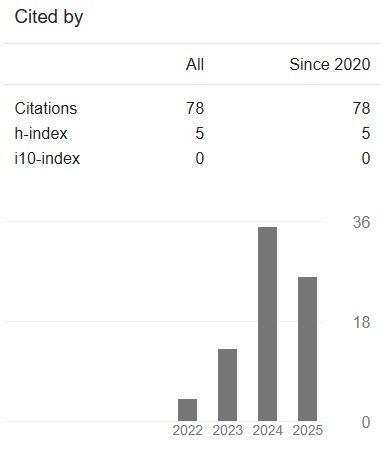Finite Element Analysis for Rocket Motor Case Under Internal Pressure and Thermal Loads
DOI:
https://doi.org/10.24191/jaeds.v2i2.47Keywords:
Stress Analysis, Rocket Motor, Combustion Chamber, Hoop Stress, ANSYSAbstract
Rocket motor combustion chamber need to contain very high pressure and temperature due to burning of rocket fuels. Although for small rocket the burning time in the combustion chamber are short about 1 to 5 seconds it is very important to make sure that the combustion chamber can hold the pressure and heat produced by the burning of the fuels. Even with a very strong material of combustion chamber and the analysis proof that the chamber is able to stand the high pressure produced there are high probability of structural failure due to the increase of temperature due to heat into the combustion chamber wall since the increasing temperature of the combustion chamber wall will decrease the strength of the material. In this study the thermal analysis was done using ANSYS software with various thickness from CC 2.5, CC 3.5 and C.C 5.0 in two condition which are the stress due to static stress and the stress due to static stress and thermal stress. The propellant properties, pressure applied, chamber temperature and heat coefficient are the same in all cases. Then the results for the different thickness stress at the wall are plotted and compared. The study shows that the results due to then static stress and overall stress with different combustion chamber thickness for the radial stress show no significant differences. While the hoop stress and von-Mises stress due to static stress are maximum at inner wall and decrease as the direction of the wall increase from the inside. In other cases where the static and thermal stress are applied, the highest stress is at the outer wall of the cylinder. The higher combustion chamber thickness, the lower hoop stress and von-Mises stress need applied to the combustion chamber wall. Thus, results in higher safety factor for the higher combustion chamber thickness.
Downloads
References
James C. Thomas, Gordon R. Morrow, Catherine A.M. Diller, and Eric L. Peterson, “Comprehensive study of ammonium perchlorate particle size/concentration effects on propellant combustion,” in Journal of Propulsion and Power, 2020, vol. 36, no. 1, pp. 95–100. doi: 10.2514/1.B37485.
K. F. Fung, Y. F. Huang, and C. H. Koo, “Assessing drought conditions through temporal pattern, spatial characteristic and operational accuracy indicated by SPI and SPEI: Case analysis for Peninsular Malaysia,” Natural Hazards, vol. 103, no. 2, pp. 2071–2101, Sep. 2020, doi: 10.1007/s11069-020-04072-y.
H. A. Israr, “An Overview of Using Unmanned Aerial Vehicle as an Alternative Solution for Cloud Seeding Process,” Johor, Jan. 2016. [Online]. Available: www.jtse.utm.my
Reuters Staff, “Smothered by smoke, Malaysia seeds clouds to bring rain relief | Reuters,” Reuters, Sep. 18, 2019. https://www.reuters.com/article/us-southeastasia-haze-idUSKBN1W31CG (accessed Apr. 18, 2022).
Mymilitarytimes Staff, “RMAF Carries Out Cloud Seeding in Kedah and Perlis - MY Military Times,” mymilitarytimes, Feb. 15, 2020. https://mymilitarytimes.com/index.php/2020/02/15/rmaf-carries-out-cloud-seeding-in-kedah-and-perlis/ (accessed Apr. 18, 2022).
News18 Staff, “How Dubai Created Artificial Rain With Cloud Seeding,” News18.com, Jul. 24, 2021. https://www.news18.com/news/buzz/read-how-dubai-created-fake-rain-with-cloud-seeding-3999557.html (accessed Apr. 17, 2022).
Mack DeGeurin, “China Used Rockets to Control Weather for Communist Party Event,” Gizmodo, Aug. 12, 2021. https://gizmodo.com/china-is-using-rockets-to-control-the-weather-1848175761 (accessed Apr. 17, 2022).
Lucas De Almeida and Geovanio Claudino Cavalcante Filho, “CFD Analysis of Drag Force for Different Nose Cone Design Potiguar Rocket Design View Project CFD Analysis of Drag Force for Different Nose Cone Design,” Brasilia, Oct. 2019. [Online]. Available: https://www.researchgate.net/publication/336345689
Emma Renee Fraley, “Design, Manufacturing, and Integration of Fins for 2017-2018 OSU ESRA 30k Rocket,” Oregon, Oct. 2018.
“ANSYS”.
G. Marra et al., “A Wide Characterization of Aluminum Powders for Propellants A WIDE CHARACTERIZATION OF ALUMINUM POWDERS FOR PROPELLANTS *,” 2004. [Online]. Available: https://www.researchgate.net/publication/280836428
K. George, B. P. Panda, S. Mohanty, and S. K. Nayak, “Recent developments in elastomeric heat shielding materials for solid rocket motor casing application for future perspective,” Polymers for Advanced Technologies, vol. 29, no. 1. John Wiley and Sons Ltd, pp. 8–21, Jan. 01, 2018. doi: 10.1002/pat.4101.
R. Haymes and E. Gal, “Transient thermal multiscale analysis for rocket motor case: Mechanical homogenization approach,” Journal of Thermophysics and Heat Transfer, vol. 31, no. 2, pp. 324–336, 2017, doi: 10.2514/1.T4929.
E. S. Habib, M. A. El-Hadek, and A. El-Megharbel, “Stress analysis for cylinder made of FGM and subjected to thermo-mechanical loadings,” Metals (Basel), vol. 9, no. 1, Jan. 2019, doi: 10.3390/met9010004.
K. Hu, F. Zhu, J. Chen, N. A. Noda, W. Han, and Y. Sano, “Simulation of thermal stress and fatigue life prediction of high speed steel work roll during hot rolling considering the initial residual stress,” Metals (Basel), vol. 9, no. 9, Sep. 2019, doi: 10.3390/met9090966.
L. A. N. Wibawa, K. Diharjo, W. W. Raharjo, and B. H. Jihad, “Stress analysis of thick-walled cylinder for rocket motor case under internal pressure,” Journal of Advanced Research in Fluid Mechanics and Thermal Sciences, vol. 70, no. 2, pp. 106–115, 2020, doi: 10.37934/ARFMTS.70.2.106115.
M. Arefi and G. H. Rahimi, “Thermo elastic analysis of a functionally graded cylinder under internal pressure using first order shear deformation theory,” Scientific Research and Essays, vol. 5, no. 12, pp. 1442–1454, 2010, [Online]. Available: http://www.academicjournals.org/SRE
V. Vullo, “Springer Series in Solid and Structural Mechanics 3 Circular Cylinders and Pressure Vessels.” [Online]. Available: http://www.springer.com/series/10616
Z.-B. Shen, L. Zhang, and Y.-F. Li, “Structural integrity analysis and experimental investigation for solid rocket motor grain subjected to low temperature ignition,” MATEC Web of Conferences, vol. 293, p. 04005, 2019, doi: 10.1051/matecconf/201929304005.
Downloads
Published
How to Cite
Issue
Section
License
Copyright (c) 2022 Mohamad Amirul Muhammad, Zuraidah Salleh, Ahmad Hussein Abdul Hamid

This work is licensed under a Creative Commons Attribution 4.0 International License.









